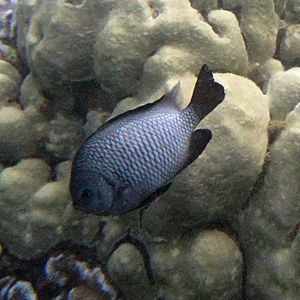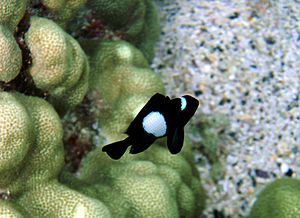Hawaiian dascyllus facts for kids
Quick facts for kids Hawaiian dascyllus |
|
|---|---|
 |
|
| Scientific classification | |
| Genus: |
Dascyllus
|
| Species: |
albisella
|
| Synonyms | |
|
Dascyllus edmondsoni Pietschmann, 1934 |
|
The Hawaiian dascyllus (scientific name: Dascyllus albisella) is a cool marine fish. People also call it the Hawaiian domino, Domino damselfish, or white-spotted damsel. You can find this fish swimming in the eastern central Pacific Ocean.
Contents
What the Hawaiian Dascyllus Looks Like
This fish can grow up to about 12.5 centimeters (almost 5 inches) long. It is usually dark gray or black. But the centers of its scales on its body are a whitish color.
Where the Hawaiian Dascyllus Lives
Hawaiian dascyllus fish love to live near coral reefs. They usually prefer shallow, calm waters where they feel safe. You can often spot them swimming in small openings, from the water's surface down to about 20 feet deep.
Where to Find the Hawaiian Dascyllus
You can find these fish swimming around the beautiful Hawaiian Islands. They also live near Johnston Island.
Hawaiian Dascyllus Behavior
Hawaiian dascyllus fish are generally calm. They spend most of their time looking for food. Males of this species are usually more protective. They are the ones who take care of the eggs and young fish.
Parental Care and Protection
It's interesting because only the male Hawaiian dascyllus usually cares for the babies. This is called "uniparental care." But this doesn't mean the female fish just lay eggs and leave. Females can become more aggressive if the male isn't around. Larger female fish are more likely to protect the nest if the male is gone. Also, females that grew up in that specific nest are often the best defenders. When both parents are present, females will also help defend the nest. They become more aggressive if there are many predators nearby. Females mainly show aggression when their eggs are in danger.
How They Communicate
Hawaiian dascyllus fish make chirping sounds to show they are aggressive. They make different sounds depending on who they are "talking" to. When they are aggressive towards other Hawaiian dascyllus fish, they make a popping sound. This sound has many short pulses. They also make these sounds when chasing younger fish. When they are aggressive towards other types of fish, they make sounds with one or two pulses. This shows they can tell the difference between their own kind and other species.
Defending Their Home (Territory)
These fish also like to claim and defend their own areas, called territories. A fish that owns a territory will usually only act aggressive when other fish try to enter its space. They often let most fish pass through their territory. But some fish are chased away right away. This might happen if the fish trying to enter is about the same size. The territory owner might see them as a threat to their control.
Young Fish and Their Groups
Young Hawaiian dascyllus fish, called juveniles, also interact with each other. They form a "pecking order" based on their size. Larger young fish are usually more dominant than smaller ones. This behavior probably helps them set up their social order early on. Fish that are lower in this social order might not grow as big. The same can happen in larger groups of fish. This might be because the group's hierarchy keeps some fish smaller. Once these fish settle into a group, they tend to stay there. Even if they find a potentially better group, they often stick with their original one. This shows they aren't always looking for a fight when choosing where to live.
See also
 In Spanish: Dascyllus albisella para niños
In Spanish: Dascyllus albisella para niños


